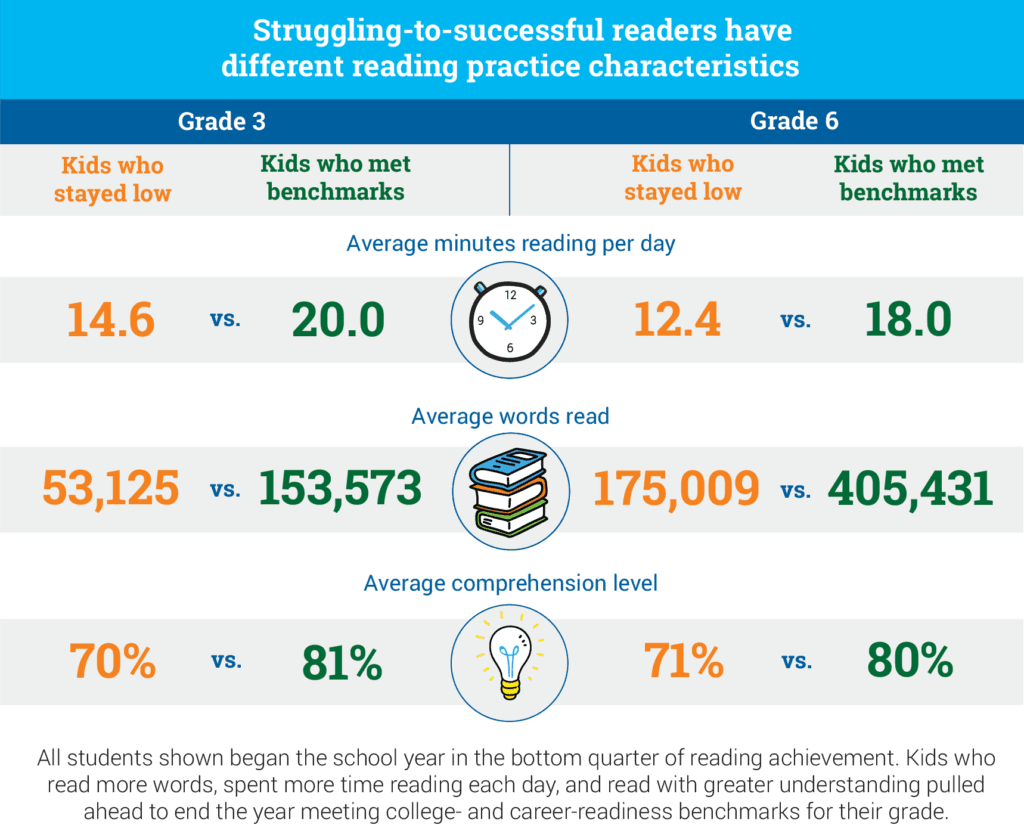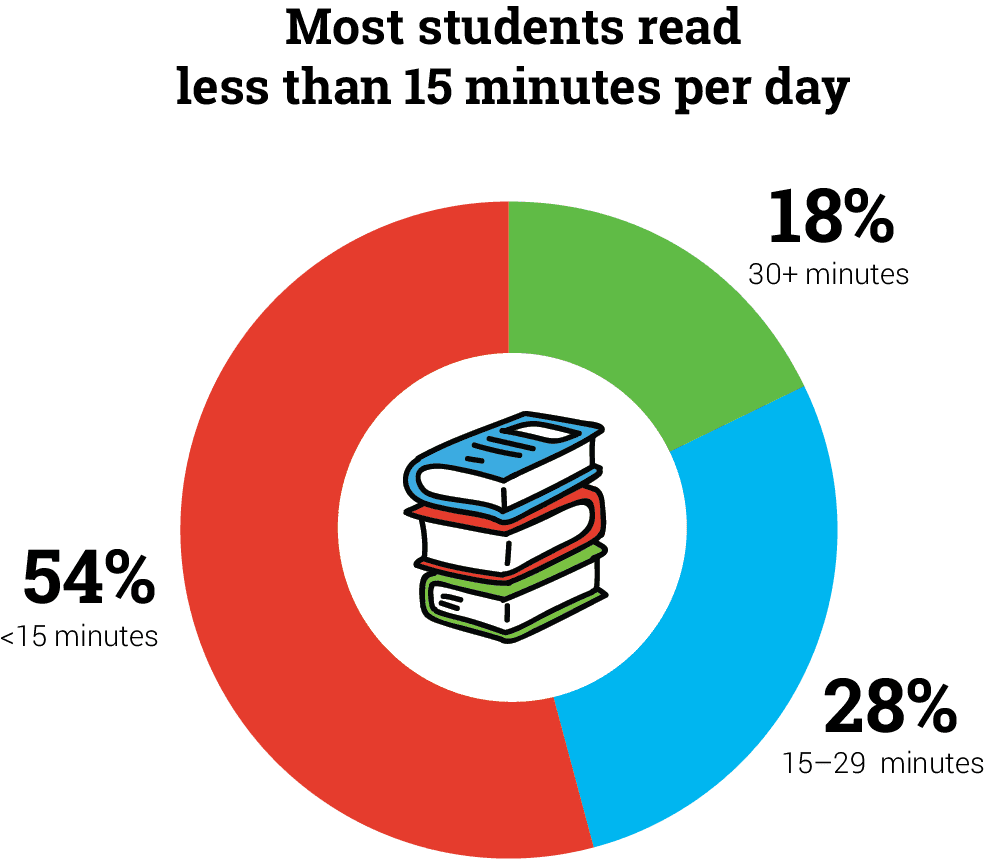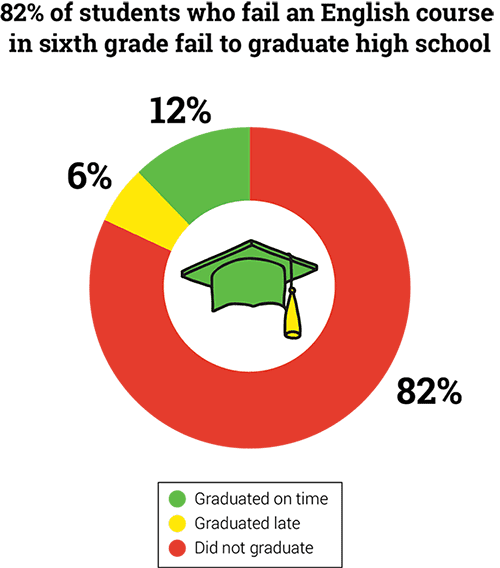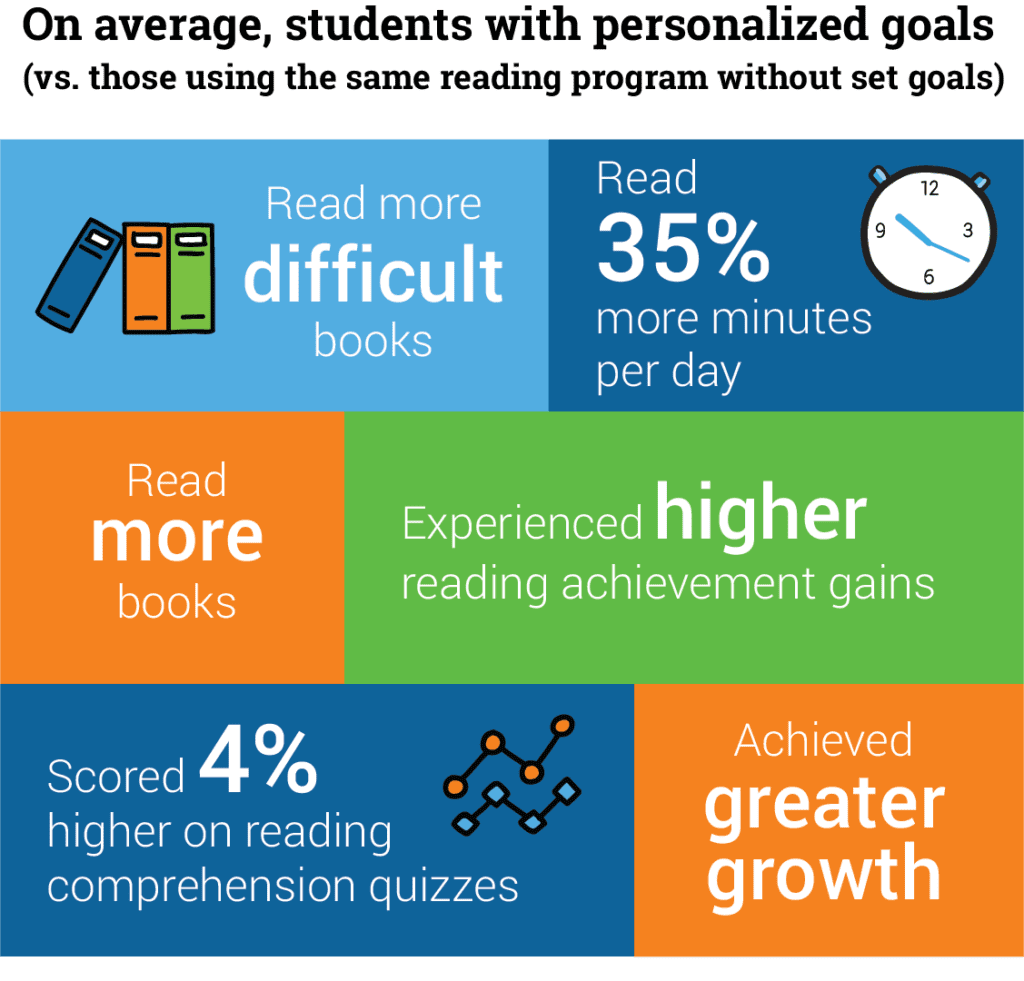Statistics About Students Who Read Vs. Students Who Don't
Can reading practice aid transform struggling readers into successful readers? And by doing so, can nosotros change the trajectory of their long-term educational careers—perchance even influence their odds of graduating from loftier school and attention college? The post-obit 10 statistics about struggling readers and reading growth, originally included in a recent article series past Renaissance, show how fifty-fifty a small-scale increase in daily reading practise could make a huge difference for all students.
Reading Practice by the Numbers:
ane. vi More Minutes
Results from the world'south largest annual study of K–12 student reading habits constitute that students who started the year as struggling readers only ended the year at or to a higher place criterion each day read simply six more minutes than struggling readers who did not run across criterion. Struggling-to-successful third graders also read 100,448 more words and had eleven percent higher reading comprehension than their peers, while struggling-to-successful sixth graders read 230,422 more than words and had 9 percent higher reading comprehension.

Source: Renaissance/6 More than Minutes
2. 15 Minutes Per Twenty-four hours
An assay of more than ix.nine 1000000 students establish that only those students who read fifteen minutes or more per day fabricated accelerated reading gains. Students who had less than fifteen minutes of daily engaged reading time saw below-average reading gains, putting them at risk of falling behind their peers. Students who read between just over a one-half-60 minutes and an hour per day saw the greatest gains of all.
3. 54 Percent of All Students
Worryingly, more than half of all students exercise non get plenty daily reading practice. A mere 18 percent of students read thirty minutes or more per day, and another 28 per centum had fifteen to 29 minutes of daily engaged reading time. The remainder—54 percent—read less than xv minutes per day!

Source: Renaissance/15 Minutes Reading
4. 23 Percentage of Third Graders
In a longitudinal study of most iv,000 students, researchers found that about i in iv students (23 percent) with "below-basic" reading skills in 3rd grade had not graduated high school by age nineteen. Among "proficient" third-form readers, only i in 25 (four per centum) did not graduate. This means proficient third-grade readers were nearly five times more likely to graduate high schoolhouse than their peers with below-basic-reading skills.

Source: Renaissance/23% of Tertiary Graders
5. 82 Percentage of Sixth Graders
In a longitudinal study of nearly 13,000 urban students, researchers found that 82 percent of 6th graders who had failed an English class did not go on to graduate from loftier school. Another 6 percent of those students who had failed English in sixth course graduated belatedly, while simply 12 percent of those sixth graders who had failed an English course went on to graduate high school at all.

Source: Renaissance/82 Percent of Sixth Graders
6. thirty Points
If y'all think reading practise doesn't affair for older students, think again. NAEP results evidence that students who read more frequently have higher scores—and the score gap betwixt frequent readers and infrequent readers gets bigger as students get older. Among nine-year-olds, there was only an 18-point difference between children who reported reading "never or hardly always" and those who read "nearly every day." By age xiii, the gap widened to 27 points. At historic period 17, information technology further increased to 30 points!
7. 13,700 Words
Some researchers gauge that children larn 1 new word for every 1,000 words read. Betwixt kindergarten and 12th class, students with an boilerplate daily reading time of 30 or more minutes are projected to encounter xiii.7 1000000 words—so they should acquire around 13,700 new vocabulary words from independent reading do alone . In contrast, students who read less than 15 minutes per day would acquire only 1,500 new vocabulary words from reading. That's a vocabulary gap of 12,200 words!
8. 35 Percent More Minutes
How can we encourage students to spend more than time reading? Set personalized goals! A written report of more than than iv.2 million students found that students with personalized goals gear up as part of a enquiry-based reading do programme read 35 percentage more minutes per twenty-four hour period, read more difficult books, and had iv% college literal comprehension scores than students who used the aforementioned program merely without set goals.
 Source: Renaissance/35 Percent More Minutes
Source: Renaissance/35 Percent More Minutes
9. 70 Percent Higher Math and Scientific discipline Scores
Reading skill matters for more than but reading! Students in the superlative tercile (i.eastward., the top third) of reading skill answered 70 per centum more than math and science questions correctly than students in the bottom tercile, even on questions with low reading difficulty. The top readers answered 66 percent of these questions correctly, compared to just 39 percentage right for the lesser readers.
10. Nearly 2X College and Career Readiness
Students who get lots of high-quality reading practice every day are much more likely to be college and career set. A written report of 2.8 million students constitute that students who read 30 or more than minutes per day with loftier comprehension (85 percentage or higher) werenearly twice more likely than typical students to accomplish the higher and career readiness benchmarks for their class as typical students.
What Can We Do With These Numbers?
Of grade struggling readers need high-quality education and intensive support in social club to learn essential reading skills. The data suggest they also need time to practice applying those skills. What if nosotros fabricated a few additional minutes of daily reading practice a reality for all struggling readers? For all students? Could this help more than students reach grade-level goals? Graduate high school on time? Stay on runway for college and career success? Imagine the possibilities!
Want More than Insights into Struggling Readers and Reading Growth?
Download the costless Teaching Leader'due south Guide to Reading Growth to become fifty-fifty more research-driven insights to support the reading growth and achievement of all students at your school.
Source: https://www.weareteachers.com/staggering-statistics-about-struggling-readers-and-reading-growth/
Postar um comentário for "Statistics About Students Who Read Vs. Students Who Don't"